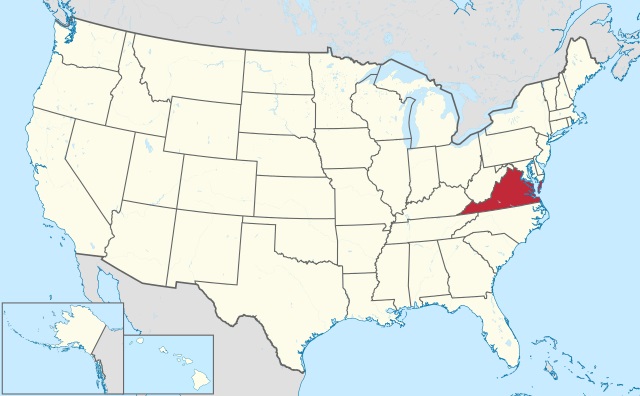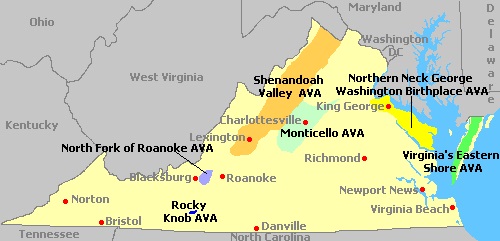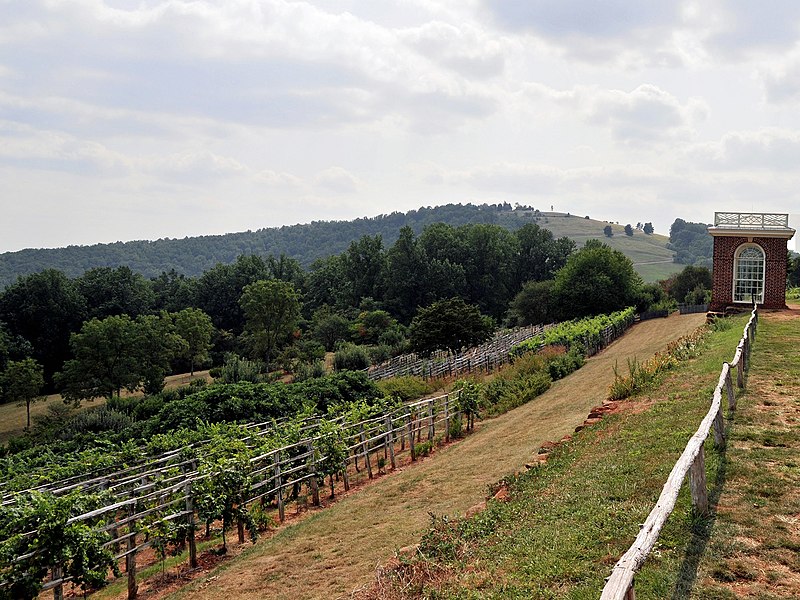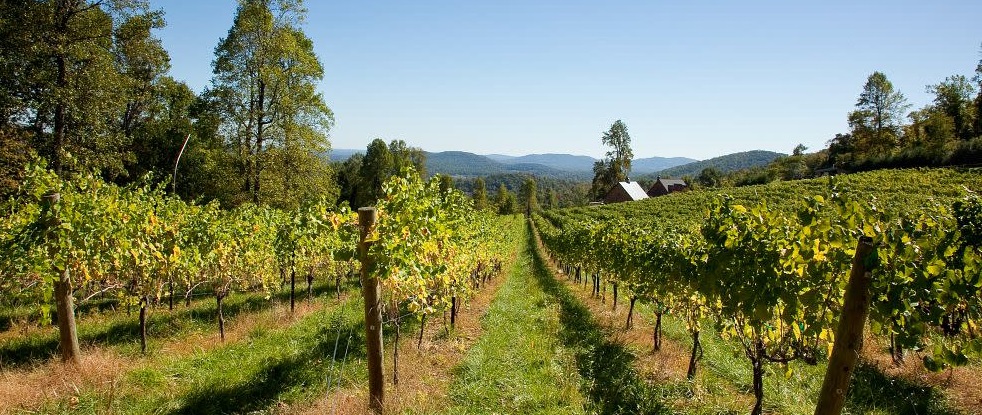Virginia Wine
Virginia is one of the most exciting and historic wine-producing states in the U.S., with a fast-growing reputation for high-quality wines. It blends Old World wine elegance with New World innovation, thanks to its diverse climates, soils, and topography.

1,600 Hectares
(4,000 Acres)
7.2 million Litres
300+ Wineries
Virginia Wine Regions

Virginia does not have as many officially designated American Viticultural Areas (AVAs) as some states, but its wine scene is geographically diverse, spanning from the foothills of the Blue Ridge Mountains to the Chesapeake Bay and beyond.
- Shenandoah Valley AVA (1982)
- Monticello AVA (1983)
- North Fork of Roanoke AVA (1983)
- Rocky Knob AVA (1983)
- Northern Neck
George Washington Birthplace AVA (1987) - Virginia Eastern Shore AVA (1991)
- Middleburg Virginia AVA (2012)
- Appalachian High Country AVA (2016)
- Virginia Peninsula AVA (2021)
Monticello (AVA 1984)

Monticello is considered the heart of Virginia wine country.
It is located around Charlottesville in central Virginia, home to Thomas Jefferson’s Monticello estate with historic roots in U.S. wine production.
Thomas Jefferson tried (and failed) to grow European grapes at Monticello due to disease pressures, but his dream laid the foundation for Virginia’s modern wine industry.

Thomas Jefferson's Monticello vineyard did not produce wine until the late 20th century.
- Climate
Warm and humid summers with cool nights due to elevation. - Soil
Clay and granite-based soils. - Grapes
Viognier
Petit Verdot
Cabernet Franc
Chardonnay
Shenandoah Valley (AVA 1982)
Shenandoah Valley is located between the Blue Ridge and Allegheny Mountains.
It is best known for aromatic whites and cooler-climate reds.
- Climate
Drier than other parts of Virginia (rain shadow effect) and cooler temperatures. - Soil
Limestone and shale. - Grapes
Riesling
Traminette
Cabernet Franc
Petit Manseng
Albariño
North Fork of Roanoke (AVA 1983)
North Fork of Roanoke is located along the eastern slopes of the Allegheny Mountains in southwest Virginia.
- Climate
Cooler, with good elevation. - Soil
- Grapes
Cabernet Sauvignon
Cabernet Franc
Viognier
Merlot
Middleburg Virginia (AVA 2012)
Middleburg Virginia is located in northern Virginia, within the Piedmont region (Loudoun and Fauquier counties).
The region is known for refined Bordeaux-style blends and elegant whites.
- Climate
Influenced by elevation and proximity to the Potomac River. - Soil
Free-draining Gravel and Sand with underlying bedrock of granite and gneiss. - Grapes
Sauvignon Blanc
Cabernet Franc
Merlot
Chardonnay
Rocky Knob AVA (est 1983)
Rocky Knob is located in higher elevations near the Blue Ridge Parkway.
- Climate
- Soil
Gravel and Loam. - Grapes
Small production. Best known for cooler-climate whites and hybrids.
Northern Neck George Washington Birthplace (AVA 1987)

Virginia's Eastern Shore AVA (1991)
The Virginia's Eastern Shore wine region is located on the southern end of the Delmarva Peninsula, with the Chesapeake Bay on one side and the ocean on the other.
The region benefits from breezes from the bay, the sandy soil, a moderate, maritime climate and a long growing season. The expressive character and minerality of Eastern Shore wines make a natural pair with the area's local seafood.
Virginia Peninsula AVA (est 2021)
The Virginia Peninsula wine region is located on the coastal southeast Virginia between the York and James Rivers. This new and developing AVA is experimenting with both european, native and hybrid grape varieties:
Norton, Chambourcin, Vidal Blanc, Traminette,
Cabernet Franc, Merlot, Chardonnay, Viognier, Albariño,
Tannat, Petite Verdot, Petit Manseng, Vasara,
- Climate
The area has a humid subtropical climate, with long, humid summers and moderate to mild winters. The growing season is 190-200 days from April 10 (the last frost) to the end of October. - Soil
The topsoil in this coastal plain includes sand, mud, and gravel, formed during times of higher sea levels. The underlying bedrock is marine sedimentary, sandstone, marine fossils, and clay, easily fractured and conducive to viticulture.
Appalachian High Country AVA (est 2016)

Virginia Grapes
Virginia’s humid and variable climate requires careful grape selection. Winemakers often look to France's Bordeaux, Rhône, and Loire Valleys, as well as native and hybrid varieties.
Native Grapes
Most of the world’s fine wine (Cabernet Sauvignon. Pinot Noir, Chardonnay) derives from the european grape species Vitis vinifera.
Unlike Vitis vinifera, American grapes like Vitis labrusca and Vitis rotundifolia are native to North America.
These varieties have natural resistance to pests and diseases, particularly phylloxera, which devastated European vineyards in the 19th century.
Native grapes have a deep-rooted presence in Virginia’s winemaking history, with key examples such as Norton and Concord.
Hybrid Grapes
Hybrid grapes are the result of crossing european vinifera and American grape species. These hybrids are especially well-suited to Virginia’s varied climate, offering both resilience and distinct flavors. Key varieties include: Chambourcin, Traminette, Vidal Blanc, and Seyval Blanc.
Red Grapes
| Grape | Description |
|---|---|
| Cabernet Franc | The signature red grape of Virginia. Floral, earthy and versatile. Its adaptability to Virginia’s climate makes it a favorite among winemakers. |
| Petit Verdot | Deep color, age-worthy, often blended or made as varietal. |
| Merlot | Soft and rounded. Used in Bordeaux-style blends. |
| Tannat | Bold, structured and increasingly popular. |
| Chambourcin | A French-American hybrid used for dry reds and rosés. |
| Norton (Native) | Virginia’s most famous native grape, known for its deep color, bold acidity, and rich blackberry flavors. It was the backbone of American wine in the 19th century and thrives in the region. |
| Concord (Native) | Known for its intense grape aroma, this grape is commonly used in juice and sweet wines but is important to Virginia’s viticultural history. |
White Grapes
| Grape | Description |
|---|---|
| Viognier | The signature white grape of Virginia. Aromatic, peachy, and often dry. |
| Chardonnay | Both oaked and unoaked styles. |
| Petit Manseng | High acid, great for sweet and dry styles. |
| Riesling | Used in cooler regions or for aromatic expressions. |
| Albariño | Used in cooler regions or for aromatic expressions. |
| Sauvignon Blanc | Gaining popularity in northern AVAs. |
| Traminette (Hybrid) | Hybrid with Gewürztraminer parentage. Offers floral aromatics and a touch of spice, making it an exciting option for white wine producers. |
| Vidal Blanc (Hybrid) | One of the most widely planted hybrids in Virginia, known for its ability to produce both dry and sweet wines, including ice wine-style dessert wines. |
| Seyval Blanc (Hybrid) |
A crisp white grape with bright acidity and citrus notes. An excellent alternative to both Chardonnay and Sauvignon Blanc. |

